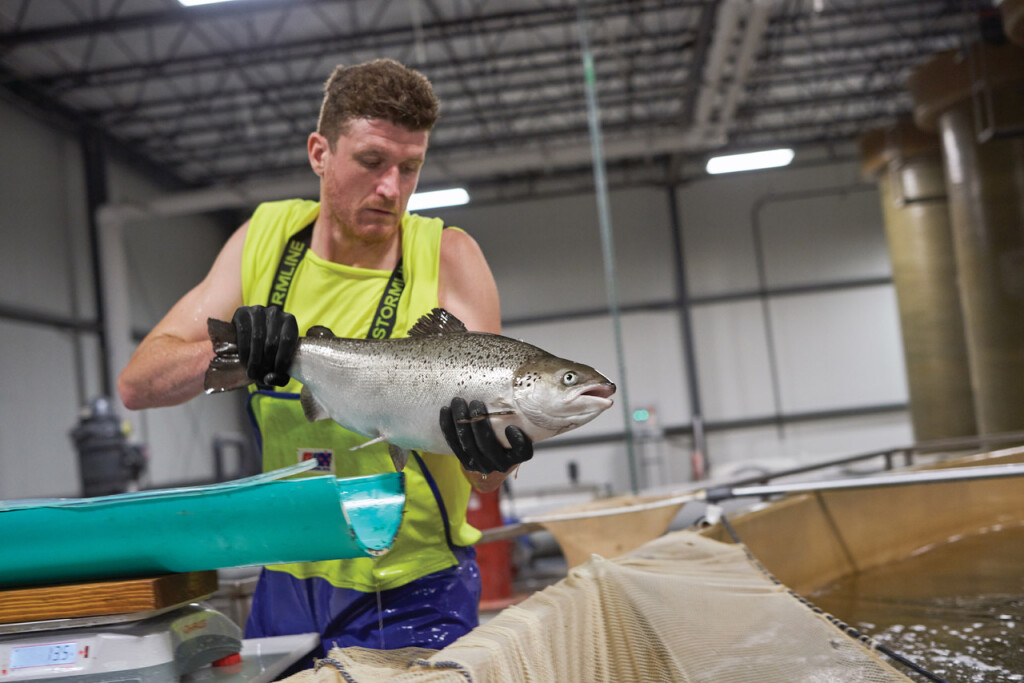AquaBounty CEO Sylvia Wulf sent a letter to shareholders this week, projecting growth and strength from the company’s investment in genetically engineered salmon, as well as an update on the plan for another U.S. facility to be located in Pioneer, Ohio.
“We began 2021 with a world-class team in place and preparations to make this our breakthrough year,” Wulf writes. “In the first quarter we completed a public offering of common stock with $127.1 million in gross proceeds, fortifying our balance sheet and positioning us to deliver on our vision for our next farm — a 10,000-metric-ton ‘farm of the future.’”
The new farm is projected to produce eight times the output of the company’s Albany, Ind., location, which was its first in the United States. The Indiana-based recirculating aquaculture system has an annual capacity of 1,200 metric tons, or 100 tons per month. AquaBounty also operates an RAS for GE salmon in Canada’s Prince Edward Island and is headquartered in Maynard, Mass. Production at the established farms is not yet near peak.
“We continued to scale production output in the third quarter, harvesting 84 tons of salmon from our two farms, and commercial interest remains high,” Wulf says. “Harvests increased 8 percent in the fourth quarter compared to the third quarter, as we set the stage for continued operational momentum going into 2022, with a full staff and arrival of additional automation equipment.”
A financial update from Wulf in November 2021 included acknowledgement of staffing challenges that were contributing to the company’s slow run up to full capacity.
MarketWatch reports that the company’s stock declined 6 percent to $1.91 following a presentation and update at the H.C. Wainwright BioConnect Conference this week.
This week’s shareholder letter included no signs of tempering investment in capacity, despite these setbacks.
“As the final design for our Ohio farm progressed, we refined our expected project cost to be in the range of $290 million to $320 million, including a reserve for potential contingencies of $30 million,” Wulf writes.
Local bonds, Wulf writes, will make a significant contribution to the investment of the new facility.
“We began the process for the placement of a mix of tax-exempt and taxable bonds through the Toledo-Lucas County Port Authority, whose board approved the issuance of up to $300 million in bonds to support the financing of the project. We also engaged Wells Fargo Corporate and Investment Banking to underwrite and market the bond placement.”
The Food and Drug Administration approved genetically engineered salmon for human consumption in the United States in 2015. Its labeling requirements have been a consistent source of concern for wild and farmed fisheries stakeholders, including a call from U.S. Senator Lisa Murkowski (R-Alaska) for labeling aimed to reduce consumer confusion.
“It is absolutely essential that consumers be fully informed about what they are buying and feeding their — especially when it comes to purchasing a genetically engineered salmon product,” Murkowski said in a press release. “As an Alaskan who knows the tremendous benefits of eating healthy, wild Alaskan salmon, it’s imperative that Americans have the information to make that choice. When you splice DNA from another animal and combine it with farmed salmon, you are essentially creating a new species, and I have serious concerns with that.”
The company also touts relationships with “large-scale retailers,” though so far only Samuels & Sons, based in Philadelphia, has gone public with its commitment to distributing GE salmon. Aramark, Sodexo and Compass Group publicly committed to a boycott of AquAdvantage salmon in early 2021.
Samuel & Sons Director of Purchasing Joe Lasprogata told SeafoodSource in August 2021 that feedback on his end had been relatively quiet.
“There have been a few emails and phone calls from people who are disappointed we’re handling this product, mostly from the general public,” Lasprogata said. “I can’t say I’ve changed anyone’s mind on it, but we’re getting facts out there.”







